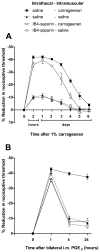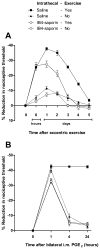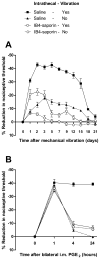IB4-saporin attenuates acute and eliminates chronic muscle pain in the rat
- PMID: 22206923
- PMCID: PMC3272112
- DOI: 10.1016/j.expneurol.2011.12.019
IB4-saporin attenuates acute and eliminates chronic muscle pain in the rat
Abstract
The function of populations of nociceptors in muscle pain syndromes remain poorly understood. We compared the contribution of two major classes, isolectin B4-positive (IB4(+)) and IB4-negative (IB4(-)) nociceptors, in acute and chronic inflammatory and ergonomic muscle pain. Baseline mechanical nociceptive threshold was assessed in the gastrocnemius muscle of rats treated with IB4-saporin, which selectively destroys IB4(+) nociceptors. Rats were then submitted to models of acute inflammatory (intramuscular carrageenan)- or ergonomic intervention (eccentric exercise or vibration)-induced muscle pain, and each of the three models also evaluated for the transition from acute to chronic pain, manifest as prolongation of prostaglandin E2 (PGE(2))-induced hyperalgesia, after recovery from the hyperalgesia induced by acute inflammation or ergonomic interventions. IB4-saporin treatment did not affect baseline mechanical nociceptive threshold. However, compared to controls, IB4-saporin treated rats exhibited shorter duration mechanical hyperalgesia in all three models and attenuated peak hyperalgesia in the ergonomic pain models. And, IB4-saporin treatment completely prevented prolongation of PGE(2)-induced mechanical hyperalgesia. Thus, IB4(+) and IB4(-) neurons contribute to acute muscle hyperalgesia induced by diverse insults. However, only IB4+ nociceptors participate in the long term consequence of acute hyperalgesia.
Copyright © 2012 Elsevier Inc. All rights reserved.
Figures



References
-
- Ambalavanar R, Moritani M, Haines A, Hilton T, Dessem D. Chemical phenotypes of muscle and cutaneous afferent neurons in the rat trigeminal ganglion. J Comp Neurol. 2003;460:167–179. - PubMed
-
- Armstrong RB, Warren GL, Warren JA. Mechanisms of exercise-induced muscle fibre injury. Sports Med. 1991;12:184–207. - PubMed
Publication types
MeSH terms
Substances
Grants and funding
LinkOut - more resources
Full Text Sources
Medical

